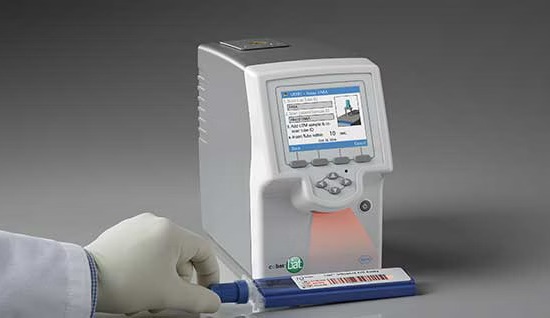New Molecular Tests Diagnose STIs at POC
|
By HospiMedica International staff writers Posted on 23 Jan 2025 |

Over one million people across the world catch a sexually transmitted infection (STI) every day. Common STIs usually present overlapping symptoms and can mostly be asymptomatic, making it challenging to achieve a diagnosis, when depending fully on symptoms. Chlamydia trachomatis (CT) and Neisseria gonorrhoeae (NG) are among the most common STIs. When left untreated, these infections can cause serious health complications, such as pelvic inflammatory disease (PID), urethritis, ectopic pregnancy, infertility, and a higher risk of HIV infection. Moreover, Mycoplasma genitalium (MG) is an upcoming sexually transmitted pathogen that affects males as well as females, with untreated infections leading to severe health issues like PID and infertility. Now, new FDA CLIA-waived tests can expand access to accurate, simple-to-use diagnostics for all patients in decentralized settings such as urgent care centers, retail clinics, and community health venues. The tests utilize highly sensitive, gold-standard PCR technology, generating results in 20 minutes to enable healthcare providers to confidently diagnose and arrive at the right treatment decision in the same visit.
Roche (Basel, Switzerland) has been granted 510(k) clearance and Clinical Laboratory Improvement Amendments of 1988 (CLIA) waiver by the U.S. Food and Drug Administration (FDA) for its cobas liat sexually transmitted infection (STI) multiplex assay panels. These panels, including tests for CT/NG and chlamydia, gonorrhea, and CT/NG/MG, allow clinicians to diagnose and differentiate between several STIs using a single sample. Over the coming months, these tests will be available exclusively in the U.S. market, followed by commercialization under the CE mark shortly. The cobas liat CT/NG and cobas liat CT/NG/MG STI assay tests further expand and complement Roche’s broad portfolio of lab-level solutions to help diagnose and address patients’ needs at the point of care. The test-to-treat approach can help reduce high loss to follow-up rates, ensuring treatment is more likely. Point-of-care testing can lower unnecessary antibiotic usage, aid targeted treatment strategies, enhance healthcare efficiency and cost, and improve the patients’ short and long-term health outcomes.
The cobas liat system, commercially available in select markets, uses gold-standard PCR technology to generate results in 20 minutes or less. The CLIA-waived cobas liat assays enable healthcare professionals to carry out molecular testing in various near-patient settings with speed, reliability, and minimal training. cobas liat is a closed system, lowering contamination risks and improving the reliability of results. The cobas liat CT/NG and CT/NG/MG assays complement existing tests for the cobas liat system. These include singleplex and multiplex assays for a variety of pathogens such as SARS-CoV-2, influenza A, influenza B, Strep A., and C. diff. These assays can be easily added to a testing program by connecting the cobas liat system to cobas infinity edge to schedule software and assay script updates remotely, and to offer remote troubleshooting across all patient-care settings. Connected cobas liat instruments streamline testing workflow and lower instrument maintenance time. Roche is also developing assays for other infectious diseases.
“Rapid molecular point-of-care testing can revolutionize the clinical management of STIs in decentralized and community-based healthcare settings, enabling informed treatment strategies, better health outcomes for patients, and contain further spread by providing timely diagnosis.” said Matt Sause, CEO Roche Diagnostics.
Channels
Critical Care
view channel
AI-Powered, Internet-Connected Medical Devices to Revolutionize Healthcare, Finds Study
A new study suggests that artificial intelligence (AI)-powered, internet-connected medical devices have the potential to transform healthcare by enabling earlier detection of diseases, real-time patient... Read more
Starfish-Inspired Wearable Tech Enables Smarter Heart Monitoring
Physical movement can make it challenging for current wearable devices to accurately track heart activity. Now, a starfish’s five-arm shape has helped resolve this issue. Inspired by the starfish's ability... Read moreSurgical Techniques
view channel
New Transcatheter Valve Found Safe and Effective for Treating Aortic Regurgitation
Aortic regurgitation is a condition in which the aortic valve does not close properly, allowing blood to flow backward into the left ventricle. This results in decreased blood flow from the heart to the... Read more
Minimally Invasive Valve Repair Reduces Hospitalizations in Severe Tricuspid Regurgitation Patients
The tricuspid valve is one of the four heart valves, responsible for regulating blood flow from the right atrium (the heart's upper-right chamber) to the right ventricle (the lower-right chamber).... Read morePatient Care
view channel
Portable Biosensor Platform to Reduce Hospital-Acquired Infections
Approximately 4 million patients in the European Union acquire healthcare-associated infections (HAIs) or nosocomial infections each year, with around 37,000 deaths directly resulting from these infections,... Read moreFirst-Of-Its-Kind Portable Germicidal Light Technology Disinfects High-Touch Clinical Surfaces in Seconds
Reducing healthcare-acquired infections (HAIs) remains a pressing issue within global healthcare systems. In the United States alone, 1.7 million patients contract HAIs annually, leading to approximately... Read more
Surgical Capacity Optimization Solution Helps Hospitals Boost OR Utilization
An innovative solution has the capability to transform surgical capacity utilization by targeting the root cause of surgical block time inefficiencies. Fujitsu Limited’s (Tokyo, Japan) Surgical Capacity... Read more
Game-Changing Innovation in Surgical Instrument Sterilization Significantly Improves OR Throughput
A groundbreaking innovation enables hospitals to significantly improve instrument processing time and throughput in operating rooms (ORs) and sterile processing departments. Turbett Surgical, Inc.... Read moreHealth IT
view channel
Printable Molecule-Selective Nanoparticles Enable Mass Production of Wearable Biosensors
The future of medicine is likely to focus on the personalization of healthcare—understanding exactly what an individual requires and delivering the appropriate combination of nutrients, metabolites, and... Read more
Smartwatches Could Detect Congestive Heart Failure
Diagnosing congestive heart failure (CHF) typically requires expensive and time-consuming imaging techniques like echocardiography, also known as cardiac ultrasound. Previously, detecting CHF by analyzing... Read morePoint of Care
view channel
Handheld, Sound-Based Diagnostic System Delivers Bedside Blood Test Results in An Hour
Patients who go to a doctor for a blood test often have to contend with a needle and syringe, followed by a long wait—sometimes hours or even days—for lab results. Scientists have been working hard to... Read more
Smartphone-Enabled, Paper-Based Quantitative Diagnostic Platform Transforms POC Testing
Point-of-care diagnostics are crucial for public health, offering rapid, on-site testing that enables prompt diagnosis and treatment. This is especially valuable in remote or underserved regions where... Read moreBusiness
view channel
Expanded Collaboration to Transform OR Technology Through AI and Automation
The expansion of an existing collaboration between three leading companies aims to develop artificial intelligence (AI)-driven solutions for smart operating rooms with sophisticated monitoring and automation.... Read more




















